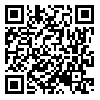Volume 8, Issue 32 (2015)
LCQ 2015, 8(32): 85-104 |
Back to browse issues page
Tehran University
Abstract: (8711 Views)
There seems to be a strong dualism throughout the novel, Chess with the Doomsday Machine, both in the images of the text and its narrator’s viewpoint. The story revolves around the eight-year Iran-Iraq War and purportedly follows the typical novels of the “Holy Defence” genre in which the most significant theme is the human choice of divine sacrifice; on the other hand, there are elements of an absurd worldview in the text in which wars and the entirety of the creation are viewed fatalistically. This dualism gets stronger in the paratexts of the novel. Paratexts, in Genette’s theory, are the surrounding elements of the text by which the text proposes itself as a book to its readers, and more generally to the public. While inner paratexts of the studied novel, like the title, the cover, and its appendages and epigraphs show an absurd viewpoint, its outer ones, such as the dedication of the work, notes of the author and the publisher’s propaganda, try to misrepresent it as a work with a “Holy Defence” discourse. Some of this dualism is because of the open ending of the story and some is due to the authorial out-of-text decisions such as choosing the publisher, Sure-ye Mehr, that is famous for its ideological books. It seems that the dualism of the paratexts of Chess with the Doomsday Machine is a result of the author’s insight into the different types of readers whose satisfaction has been at the center of the author’s attention.
Keywords: Chess with the Doomsday Machine, Gerard Genette, paratext, the Holy Defence discourse, determinism, free will
Article Type: practical |
Subject:
contemporary Persian fiction
Received: 2015/05/25 | Accepted: 2015/12/6 | Published: 2015/12/22
Received: 2015/05/25 | Accepted: 2015/12/6 | Published: 2015/12/22
| Rights and permissions | |
 |
This work is licensed under a Creative Commons Attribution-NonCommercial 4.0 International License. |



